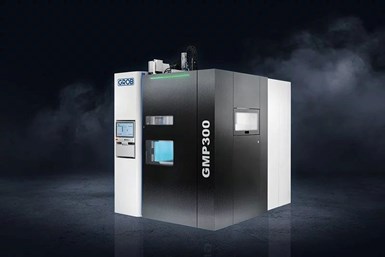GROB Metal Printing System for Near-Net-Shape Components
The process is said to offer a higher buildup rate than comparable PBF systems, and with better component resolution compared to current direct energy deposition processes.
Share
Read Next

Photo Credit: GROB
GROB’s GMP300 is a liquid metal printing system developed to provide customers with additive manufacturing (AM) of near-net-shape components. The company says this production system is well suited for prototype manufacturing as well as for small- and medium-sized series components, highly customizable components or those with complex geometry.
The company says it developed liquid metal printing (LMP) to help eliminate the disadvantages of traditional AM in the metalworking sector. This printer is designed to offer customers a reliable, efficient and cost-conscious system technology with maximum production flexibility for individual and small-series production.
GMP stands for GROB metal printing and 300 for the size of the work area — 300 × 300 × 300 mm³. The GMP300 is equipped with 3-axis kinematics and maximum axis speed of 30 m/min. The inert atmosphere is said to protect components from oxidation and to guarantee consistent, good material quality.
In contrast to the powder bed fusion (PBF) process, the raw material for the LMP process is wire. This is said to reduce material costs, while also posing no health or explosion hazard, thereby making personal protective equipment simpler and omitting additional work steps such as component depowdering and the sifting/processing of the powder. Also, the LMP process is a microcasting process and not a welding process, having little to no thermal warping which is said to enable the processing of nonweldable alloys.
The LMP process is also said to generate a homogenous microstructure with yield strengths equal to or sometimes greater than the raw material values. In addition, the process is said to provide high flexibility and productivity. Flexibility is achieved through the ability to change materials quickly with no excessive cleaning effort due to the process’ variable drop diameter and ability to change both the printhead and nozzle during the buildup process. The high productivity of the LMP process is achieved primarily via the high buildup rates, reduced postprocessing work and the fact that the component costs scale to only slightly above the filling level of the construction base, the company says.
Related Content
-
AM 101: What Is Binder Jetting? (Includes Video)
Binder jetting requires no support structures, is accurate and repeatable, and is said to eliminate dimensional distortion problems common in some high-heat 3D technologies. Here is a look at how binder jetting works and its benefits for additive manufacturing.
-
Possibilities From Electroplating 3D Printed Plastic Parts
Adding layers of nickel or copper to 3D printed polymer can impart desired properties such as electrical conductivity, EMI shielding, abrasion resistance and improved strength — approaching and even exceeding 3D printed metal, according to RePliForm.
-
3D Printing Molds With Metal Paste: The Mantle Process Explained (Video)
Metal paste is the starting point for a process using 3D printing, CNC shaping and sintering to deliver precise H13 or P20 steel tooling for plastics injection molding. Peter Zelinski talks through the steps of the process in this video filmed with Mantle equipment.














